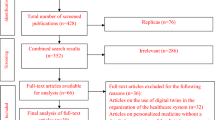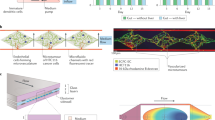Abstract
Digital Twins (DTs) are a promising technology for integrating device monitoring and data consumption to improve performance. This technology has seen utilisation in various industries that use cyber-physical systems. An unexpected area is medical devices. In this paper, we explore DTs use for an organ preservation device, which, helps improve transplantation outcomes by actively managing the organ during transport to prevent biological degradation.
Whilst reducing the burden on specialists. Digital twinning offers an exciting direction of development for medical devices to improve transplantation outcomes.
Supported by ScubaTx™ Ltd. https://www.scubatx.com.
Access this chapter
Tax calculation will be finalised at checkout
Purchases are for personal use only
Similar content being viewed by others
Notes
- 1.
This is a time constant that describes how long it would take for the oxygen flow to stabilise.
- 2.
The post process of a preserved pancreata to make its islets viable for transplantation.
References
OPTN/SRTR 2018 annual data report. Am. J. Transp. 20(s1), 1–10 (2020). https://doi.org/10.1111/ajt.15670
Alemzadeh, H., et al.: Analysis of safety-critical computer failures in medical devices. IEEE Secur. Priv. 11(4), 14–26 (2013)
Aluko, S.: Development of a Mobile Monitoring Application for a Persufflation Device. Master’s thesis, School of Computing, Newcastle University, UK (2022)
Babic, B., et al.: Algorithms on regulatory lockdown in medicine. Science 366(6470), 1202–1204 (2019). https://doi.org/10.1126/science.aay9547
Blochwitz, T., et al.: The functional mockup interface 2.0: the standard for tool independent exchange of simulation models. In: Proceedings of the 9th International Modelica Conference. Munich, Germany (2012)
Boulos, M.N.K., et al.: Digital twins: fFrom personalised medicine to precision public health. J. Personalized Med. (2021). https://doi.org/10.3390/jpm11080745
Buhagiar, A.J.: Automated organ transplant preservation smart audit. Master’s thesis, School of Computing, Newcastle University, UK (2020)
Buhagiar, A.J., Freitas, L., Scott, W.E.: Persufflation—current state of play. Transplantology (2021). https://doi.org/10.3390/transplantology2030035
Clifford, H.: Modelling data extraction protocols for an organ preservation machine. Bachelor’s thesis, School of Computing, Newcastle University, UK (2022)
De Deken, J., et al.: Hypothermic machine perfusion in kidney transplantation. Curr. Opin. Organ Transplant. 21(3), 294–300 (2016)
Department of health and human services, centers for medicare & medicaid services: organ procurement organizations (OPOs) (CMS-3380) (2020). https://www.cms.gov/files/document/112020-opo-final-rule-cms-3380-f.pdf
FDA: Proposed regulatory framework for modifications to artificial intelligence/machine learning based software as a medical device (SaMD) (2019)
General principles of software validation: standard. International Organization for Standardization, USA (2002)
Feng, H., et al.: The incubator case study for digital twin engineering. Tech. rep., Aarhus University (2021). https://arxiv.org/abs/2102.10390
Feng, H., et al.: Integration of the Mape-K loop in digital twins. In: Submitted to IEEE Modelling and Simulation. IEEE (2022)
Fitzgerald, J., Larsen, P.G., Pierce, K.: Multi-modelling and co-simulation in the engineering of cyber-physical systems: towards the digital twin. In: ter Beek, M.H., Fantechi, A., Semini, L. (eds.) From Software Engineering to Formal Methods and Tools, and Back. LNCS, vol. 11865, pp. 40–55. Springer, Cham (2019). https://doi.org/10.1007/978-3-030-30985-5_4
Freitas, L., et al.: Medicine-by-wire: practical considerations on formal techniques for dependable medical systems. Sci. Comput. Prog. (2020). https://doi.org/10.1016/j.scico.2020.102545
Gerke, S., et al.: The need for a system view to regulate artificial intelligence/machine learning-based software as medical device. NPJ Digit. Med. 3(1), 53 (2020). https://doi.org/10.1038/s41746-020-0262-2
Grieves, M., Vickers, J.: Digital twin: mitigating unpredictable, undesirable emergent behavior in complex systems. In: Kahlen, F.-J., Flumerfelt, S., Alves, A. (eds.) Transdisciplinary Perspectives on Complex Systems, pp. 85–113. Springer, Cham (2017). https://doi.org/10.1007/978-3-319-38756-7_4
Hosgood, S.A., et al.: Reducing proinflammatory signaling and enhancing insulin secretion with the application of oxygen persufflation in human pancreata. Transplantation 103(1), 13–14 (2019)
Hrgarek, N.: Certification and regulatory challenges in medical device software development. In: 2012 4th International Workshop on Software Engineering in Health Care (SEHC), pp. 40–43 (2012). https://doi.org/10.1109/SEHC.2012.6227011
Medical device software - Software life cycle processes. Geneva, CH (2006)
Taylor, M.J., et al.: Current state of hypothermic machine perfusion preservation of organs: the clinical perspective. Cryobiology 60(3), S20–S35 (2010). https://doi.org/10.1016/j.cryobiol.2009.10.006
Kuca, K., et al.: The potential of medical device industry in technological and economical context. Therapeutics Clin. Risk Manag., 1505 (2015). https://doi.org/10.2147/tcrm.s88574
Laubenbacher, R., et al.: Using digital twins in viral infection. Science 371(6534), 1105–1106 (2021). https://doi.org/10.1126/science.abf3370
Legaard, C.M., et al.: Constructing neural network-based models for simulating dynamical systems (2021)
Miller, J.: Using formal methods to design, model, and verify the goals of a communication protocol between a perfusion machine and its consumable components. Bachelor’s thesis, School of Computing, Newcastle University, UK (2020)
Minor, T., et al.: Rewarming injury after cold preservation. Int. J. Mol. Sci. 20(9), 2059 (2019). https://doi.org/10.3390/ijms20092059
NHSBT: organ donation and transplantation activity report 2019/20 (2020). www.odt.nhs.uk/statistics-and-reports/annual-activity-report/
Nipkow, T., Wenzel, M., Paulson, L.C. (eds.): Isabelle/HOL. LNCS, vol. 2283. Springer, Heidelberg (2002). https://doi.org/10.1007/3-540-45949-9
Patrono, D., et al.: Hypothermic oxygenated machine perfusion of liver grafts from brain-dead donors. Sci. Rep. (2019). https://doi.org/10.1038/s41598-019-45843-3
Tao, F., et al.: Digital twin in industry: state-of-the-art. IEEE Trans. Ind. Inform. 15(4), 2405–2415 (2019). https://doi.org/10.1109/TII.2018.2873186
Tempelman, L.A., et al.: Perfusing an organ with an in situ generated gas (9 Oct 2018). US Patent 10091985
Thule, C., et al.: Maestro: The INTO-CPS co-simulation framework. Simul. Model. Pract. Theor. 92, 46–61 (2019). https://doi.org/10.1016/j.simpat.2018.12.005
Topol, E.: The Topol Review: preparing the healthcare workforce to deliver the digital future. Technical Report, Health Education England (2019)
Tudor, N., et al.: ScubaDIVE: D1 - Sprint 1 Report. HUBCAP (2021)
Tudor, N., et al.: ScubaDIVE: D2 - Sprint 2 Report. HUBCAP (2021)
Voigt, I., et al.: Digital twins for multiple sclerosis. Frontiers in Immunology 12 (2021). https://doi.org/10.3389/fimmu.2021.669811
Zeng, J., et al.: A survey: cyber-physical-social systems and their system-level design methodology. Future Gener. Comput. Syst. 105, 1028–1042 (2020). https://doi.org/10.1016/j.future.2016.06.034
Acknowledgements
We are grateful to the Poul Due Jensen Foundation, which has supported the establishment of a new Centre for Digital Twin Technology at Aarhus University. Also, for EU industrial PhD bursary (IIIP), and for ScubaTx™ for access to their device, which UK MRC funded the first prototype.
Author information
Authors and Affiliations
Corresponding author
Editor information
Editors and Affiliations
Rights and permissions
Copyright information
© 2022 The Author(s), under exclusive license to Springer Nature Switzerland AG
About this paper
Cite this paper
Buhagiar, A.J., Freitas, L., Scott III, W.E., Larsen, P.G. (2022). Digital Twins for Organ Preservation Devices. In: Margaria, T., Steffen, B. (eds) Leveraging Applications of Formal Methods, Verification and Validation. Practice. ISoLA 2022. Lecture Notes in Computer Science, vol 13704. Springer, Cham. https://doi.org/10.1007/978-3-031-19762-8_3
Download citation
DOI: https://doi.org/10.1007/978-3-031-19762-8_3
Published:
Publisher Name: Springer, Cham
Print ISBN: 978-3-031-19761-1
Online ISBN: 978-3-031-19762-8
eBook Packages: Computer ScienceComputer Science (R0)




